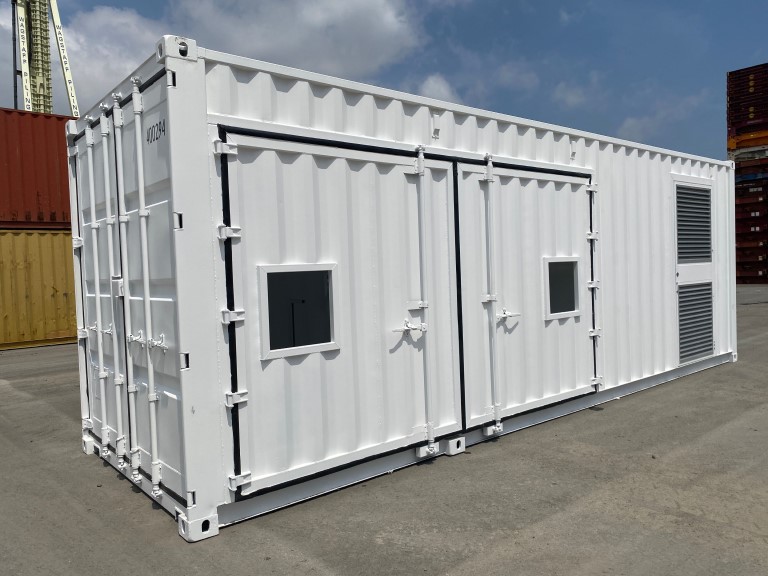Shipping containers can be used for a wide variety of things from outbuildings, to student homes and beyond but despite the variety of uses, how do the shipping containers measure up in a fire? Are shipping containers fireproof?
In this article, we look at the uses of shipping containers in terms of fire protection. We discuss whether you can use shipping containers as a safe place in case of a fire breakout and as a fire containment system.
Are shipping containers fireproof?
Shipping containers are made from a durable material that can withstand fires. The outside of the structure is made with marine-grade corten steel, which has been shown to be fireproof in tests and not compromised by flames.
There are set international rules and regulations as to what degree shipping containers should resist fire. However, the last documented test regarding their survivability in a fire was in 1977, when a US Coast Guard performed a chain of tests.
The research was a repeat of a former test done in the Netherlands in 1973. It concluded that “a fire inside a container (regardless of the cause) will not inflict very much harm on the container in question and certainly not on adjacent containers.”
The research discovered that the fire in the container consumed all the oxygen and extinguished itself. The logic is simple; you need oxygen to have a fire.
The fact that shipping containers can contain their fire is a good characteristic. Imagine having about 5,000 shipping containers stacked on a container ship. It means the ship will not go ablaze if one container catches fire.
However, don’t think that hiding in a container from a bush fire is the best thing to do.
Fire safety regulations and measures for shipping containers
Some of the regulations and measures include;
- Communicating in advance the fire safety hazards of the container
- Set out national and local state regulations of the function of the shipping vessel as a short-term building and structure
- Regulating the types of materials you store in the containers
- Providing up-to-date information on the modification of a shipping container so that it becomes safe
- Have a standard operating procedure that the fire service may use to deal with container fires
Can shipping containers be used for fire protection?
The answer is yes, shipping containers such as the ones Gateway sell can be used for fire protection. They are made of fireproof materials and can withstand high temperatures.
There are regulations in place to ensure the safety of those using shipping containers as well as the general public. Shipping containers can be a great asset in the event of a fire.
However, it is important to note that while shipping containers can withstand fires, they are not necessarily designed for people to take refuge inside of them during a fire. If you are looking for a safe place to take refuge during a fire, it is best to follow the advice of local authorities and emergency services.
How Shipping Containers are used for Fire Protection and Prevention
Modular fire stations
Many cities are now using shipping containers as modular fire stations.
Shipping containers make perfect fire stations because they are already designed to withstand the harshest weather conditions and they are made out of durable materials that can easily be cleaned and maintained. They also offer a lot of flexibility in terms of layout and design, which makes it easy to customize them to meet your specific needs.
One of the most important things to consider when using shipping containers for fire protection is the type of insulation that you will use. Shipping containers are made out of metal, which means that they conduct heat very well. This is why it is important to use a type of insulation that will not only keep the heat out but will also not catch fire easily.
Some of the most popular types of insulation for shipping containers include fibreglass, rock wool, and spray foam. All of these options are fire resistant and will help to keep your modular fire station cool during the hot summer months.
Another important consideration when using shipping containers for fire protection is the type of doors that you will use. Shipping container doors are typically made out of steel, which is extremely durable and fire-resistant. However, it is important to make sure that the doors are equipped with self-closing mechanisms in order to prevent a fire from getting out.

Firefighting systems
Shipping containers do survive fires. So, the containers get used as firefighting training facilities. And who knows, maybe someday we may use them to fight fires independently.
Joseph M Heim Training Grounds
The Joseph M Heim Training Grounds consist of a number of shipping containers that have been modified so firefighters can work in real world situations. Five containers have been set up over two storeys to create a practice area. One of these has a ‘burn room’ where firefighters can practice putting out fires in dark, smoky conditions where in others, there are smoker generators so they can practice rescues in very low visibility. With support from local businesses, the whole system cost the East Dubuque Fire Department only US $20,000 to put together.
Sea-Can self-contained fire fighting unit
A serial inventor, Eddie Paul, came up with a fire fighting unit that you can drop into the fire and put off up to 50 metres away from the container.
You can also leave the container in an area at high risk of fire. When temperatures nearby reach 93 degrees, the walls fall down. On reaching 100 degrees, the unit shoots fire retardant foam up to 50 metres from the unit. It then provides a safe zone where the fire will not get close to the container.
The heat around the container powers the unit. So, when the temperatures fall below 100 degrees, the system stops shooting the foam.
Strategies and safety measures for fire prevention
Did you know that in case your home catches fire, you have as little as two minutes to get out? An early warning from a smoke alarm and a practised escape plan can save your life in such a scenario. If you can, install an alarm in your home or workplace.
Check out what strategies and safety measures to put in place to keep your loved ones safe.
Check out the hazards
When designing a fire prevention plan, look at the potential hazards that cause a fire. Such potentials include flammable liquids, cooking, heating, electrical, and welding equipment.
Ensure that building structures are up to code
Review all the construction aspects, including roof type interior and exterior finishing materials. The building design should fit its use, the activities, and the occupants.
Ideally, a building should either be:
- Fire resistive: has the best fire-resistive rating, reinforced concrete or protected steel.
- Non-combustible; the primary materials used in construction are not combustible, e.g., hollow concrete blocks.
Inspect buildings and equipment regularly
Both buildings and equipment wear out with time. Therefore, fire-resistant materials may become less effective. Allow qualified personnel like an electrician to do an annual examination on your apartment for any repairs. High-risk equipment checks should be more frequent.
Build awareness
To prevent a fire incident or accident at work, your staff must play a role in it. Train your employees or loved ones and build awareness on fire prevention. This will help lower the risk of fire occurrences.
Create a reporting culture of fire hazards, incidents, and near misses
Encourage your employees to report any fire incidents or threats fast. Make the process simple because they may shy away from registering if it’s complex.
If a fire almost occurs, management should be aware. When managers study the root cause of previous incidents, they’ll be able to take precautions to prevent future recurrence.
Take caution
Take caution based on hazards. For example, be extra careful when handling explosive substances.
Also, additional cautions include:
- Unplug electrical appliances when not in use
- Do not crush cords
- Dispose of spills and garbage in an appropriate way
- Employees should smoke in designated areas
Formalise fire prevention strategies
Once you identify strategies to be implemented, you need to formalise them. Make the plan public by displaying them somewhere that all can see.
If your home or office catches fire, GET OUT! Don’t go back for anything!

Gateway Container Sales
We have a variety of shipping containers that may well suit your needs. Contact our friendly team today or get a free quote.




